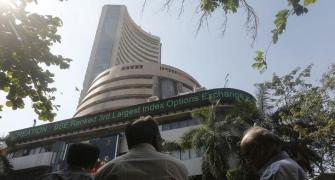Space. That's the need of the hour for Indian industry, looking to grow in every direction. Companies are looking to occupy every inch of land they can lay their hands on to keep on their unprecedented expansion spree.
Inevitably, property speculation has emerged perhaps the hottest topic across boardrooms. Not just in India. The big guns of global realty are watching Indian real estate prices ever so closely as the country looks for ways to meet a demand for around 1,000 million square feet property over five years across seven major cities.
Those in the queue include top real estate funds managed by the likes of Blackstone, Broadstreet, Carlyle, Deutsche, Hines and Morgan Stanley.
And once they are in, these big funds -- with corpuses of more than $10 billion each -- may just re-landscape the Indian realty space. Like their equity counterparts, they are known to pump in big money and move in fast once they have figured out the local dynamics. Before you realise what, they may be sitting on huge chunks of land.
Explains a senior executive of a leading real estate fund in the US: "Each of our global fund managers run through about 700 actionable mails (where they have to take a decision on the spot) a day. The pace is very fast and we don't mind if we make a few mistakes along the way. The stakes are too high for us to slow down."
Not surprisingly, global funds are seen as aggressive risk-takers and conservative Indians might do well to start preparing for their big-ticket entry that's looking imminent.
And going by the great land rush across India, it seems India Inc is preparing for the deep pockets. Players from Reliance to Tatas to Infosys to Indiabulls are engaged in a never-before race to amassing land wherever it is available. We don't associate these names with real estate.
But then, that proves the immense potential of the sector. "Land is finite, money is infinite," quips a developer, hinting that the property boom is far from over. Instead, it has just begun.
The Foreign Interest
With rental yields in the US and Europe dipping to about 4-5%, squeezed by inter-fund trading given the lack of significant new realty development, funds are increasingly eyeing opportunities in emerging economies.
In Asia particularly, with Japan -- the biggest investment destination for such funds -- providing limited scope for growth given the land constraint of the island nation, a significant part of the region's allocation is seen flowing into China and India, two markets that provide scale for long-term investments.
"Foreign capital is looking for markets, where they can get returns. India is one such market where they can expect a return of 20% a year," says Shahzaad Dalal, vice chairman & managing director, IL&FS Investment Managers, the managers of IL&FS Realty Fund that has CalPERS, the US pension fund, as an investor.
Says Sanjay Verma, joint managing director, Cushman & Wakefield, "The drivers of investments for foreign investors outside the developed world are: need for diversification, to cash in on distress sale opportunities, high short-term price upsides and long-term growth potential. India and China fall in the last category and most investors will be looking at these realty markets with a 10-15 year perspective."
Agrees Elizabeth Dewitt, vice president, Trammell Crow Company, US, "Foreign investors were checking India out for the last five years. Now they are taking a long-term view on India."
So, what's the kind of money they are likely to bring in? Ankur Srivastava, managing director (India) of DTZ Debenham Tie Leung, a leading real estate advisor, sees at least 50 overseas investors coming in with $6.7 billion in equity, which leveraged could spell fresh investments to the tune of $15 billion.
And like in the equity market, foreign funds don't mind being the "loss leaders," meaning they don't mind losing some money in the early years to gain an entry and better understand the local dynamics. They'll wait to rake in the big bucks in the long-term.
Does this mean realty is set for a foreign fund-fuelled bull run, like the equity markets? Not quite. Real estate investments are not as easy to get into and get out of, thus the pace of investments is slower.
So while we are likely to see an up-tick in prices in the longer-term for sure, it might lack the fireworks of the equity market. Also, says Prakash Gurbaxani, CEO, TSI Ventures, "Entry of foreign investors does not affect prices on a stand-alone basis, price is more a function of demand and supply." TSI Ventures is a joint venture between ICICI Ventures and Tishman Speyer, one of the world's largest developers.
Now, despite India opening up the real estate industry to foreign direct investment (FDI is under automatic approval route for projects of at least 25 acres or a minimum built-up area of 50,000 square metre), it remains an over-regulated sector with archaic regulations.
So, foreign investors are looking to enter through joint ventures with local players who understand the regulations and other dynamics of the market. Morgan Stanley Real Estate Fund, for instance, has come in by taking a stake in Bangalore-based Mantri Developers. Emaar Properties of Dubai, which has brought in the largest FDI in the sector of $500 million so far, has entered into a joint venture with MGF Developments for residential, commercial and hospitality projects in India.
Says Shravan Gupta, managing director, Emaar MGF, "We plan to develop integrated townships of international standards that will raise the bar by bringing in best practices in technology, design, construction scale and most importantly, the consumer's expectation of his living and working space."
The India Story
To these global investors, India offers an opportunity that can absorb billions of dollars unlike many other markets. "On a macro level India is a good destination. Real estate is a subset of overall growth story," says Gurbaxani.
The prime driver for all these investors is the India economic and demographic story -- by 2010 India is slated to be the world's third largest economy with a 300 million strong middle class that's larger than the US's.
The IT sector alone would require about 66 million square feet of space by 2008, as per a Ficci survey. Industry expects a demand for 25 million sq ft for 200 malls coming up across the country, besides a significant surge in the hospitality sector.
Says Ashwin Ramesh, director, Prime Real Estate Advisors (an affiliate of Quantum Asset Management): "India has a mere 85,000 hotel rooms, compared to 135,000 in Las Vegas alone." On the residential side, Milind Korde, MD, Godrej Properties, puts the shortage of dwelling units at 20 million. This should see the real estate opportunity grow to $50 billion by 2010 from $12 billion today, say sources.
Cushman & Wakefield has estimated cumulative demand across Bangalore, Chennai, Hyderabad, Kolkata, Mumbai, NCR and Pune at 840-1055 million square feet for 2006-2010.
This is the kind of projection that has made companies with no interest in real estate whatsoever till a few years ago enter the field. Reliance has bought a 14 acre plot in Mumbai's Bandra Kurla Complex for Rs 1,104 crore (Rs 11.04 billion); Indiabulls has put up Rs 441 crore (Rs 4.41 billion) for the Elphinstone Mills land in the city; Bata India is developing 260 acres of land it owned in Kolkata; SSI, an erstwhile software company, is building a township in Perambur in Chennai. . .
And then, there's a bigger realty game -- the special economic zones (SEZs). Everybody is rushing to join the SEZ bandwagon.
Reliance has already earmarked Rs 40,000 crore (Rs 400 billion) for a 25,000-acre project in Haryana. DLF Commercial Developers is investing Rs 800 crore (Rs 8 billion) in a 1,100 acre SEZ in Amritsar; Unitech has obtained clearance for a Rs 10,000 crore (Rs 100 billion), 20,000-acre SEZ in Haryana; Ansals have tied up with housing finance major HDFC for developing a Rs 1,000-crore (Rs 10 billion) IT SEZ in Noida (NCR).
And there are many more who have already clinched the deal or are in the queue. Says Pradeep Jain, chairman, Parsvnath Developers, which plans to set up 14 SEZs in the country at a cost of Rs 40,000 crore: " We have already tied up 6,000 acres of land and will start delivering developed property in the next two to three years."
Critics say the whole SEZ programme is a major land scam whereby corporates are amassing huge chunks of land at subsidised rates. And there's widespread criticism that the SEZs are not all about exports.
A comment by Anand Jain, director, Reliance Venture (the SPV floated for the project), lends weight to this school: "The multi-product SEZ should attract the top Fortune 500 companies and would have a theme park in a possible tie-up with Disney, Time Warner or Universal." Of course, there's a fun factor in the SEZs. The question is, will it be at the expense of the taxpayers?
SEZ, of course, is a controversy. And foreign players are keen to keep out of controversies. They are much more interested in realty projects in the hospitality (hotels) and IT/ITES sectors as the properties are normally of high quality and offer good returns.
Land Mafia
So, does the entry of big money mean the property prices are going to scale new highs? Nope. "Entry of foreign investors does not affect prices on a stand-alone basis, price is more a function of demand and supply," says Gurbaxani.
And in India, the supply side (land) holds the key. Land being a state subject, the laws and regulations vary from state to state. Besides, old laws like the Urban Land Ceiling & Regulation Act (ULCRA) are still to be repealed across many states.
Deepak Parekh, chairman, HDFC, points to estimates that expect real estate business to grow at 14% by 2011-12 if the Act is repealed to make a case for this. He also expects that this would curtail property prices by 40% in the next 5-6 years.
Says Manisha Grover, national director (research and strategic consulting), Jones Lang Lasalle, an international property adviser: "The key challenge in the development business in India lies in the procurement of land ready for commercial exploitation. This because of the high fragmented land holdings, title issues and infrastructure constraints that artificially restrict land supply." And the situation is unlikely to change in the near future.
What this means is that if you have control over a large land bank, you can rake in big money. Land being the raw material for development a large inventory ensures higher production and revenues. It is with a view that the laws are unlikely to change in the near future that developers are going all out to acquire as much land as they can and as soon as possible.
The land hoarding game has just begun and it could get uglier with more and more players joining the fray. Foreign investors also do not want to get involved in the land acquisition game -- they prefer coming in when land for projects has already been acquired, even if the returns are lower.
While developers look at returns of up to 50%, foreign investors are comfortable with even half that. They wish to play it clean and do not wish to get involved in unethical deals or legal battles.
"Foreign investors are extremely compliant," states Alok Vajpeyi, vice chairman and managing director, Dawnay Day AV Financial Services, an institutional realty investor. Implying, this means tremendous bargaining power for developers with large land banks.
In fact, there have been cases of proposals for tie-ups by foreign realty players with large developers not going through due to the valuation.
In this context, land being allotted at subsidised rates for development, as in the case of SEZs, by states offers an opportunity few would let go. However, here too any failure to complete the acquisition of the minimum required land area could put paid to any plans for development.
Besides, an SEZ coming up in the vicinity of a commercial and retail district could hurt other developers -- as their land costs are much higher. So the stakes are high.
But the real estate players are not unduly worried about the extra competition. "If you deliver quality stuff and on time, then there are no dearth of takers. And there is enough space in this sector for a few more players," says Pranav Ansal, director, Ansal API, one of the major developers in the country with nearly 6,000 acres as land bank.
The Price Prop
What's also helping keep prices firm for now, in what some believe to be an overpriced market, are supply factors -- little land supply and lots of money supply. Developers earlier were mostly buying and developing land with their own reserves and borrowings. Hence they would sell off the real estate at various stages of the project to fund new projects.
However, with foreign funds pumping in money their holding capacity has increased -- helping them to keep supply tighter. And the fund supply is only going to swell. According to industry insiders, $4 billion of realty fund investment is waiting to enter, with $1 billion already having received all regulatory clearances.
Some, however, believe the money may not flow in right away. "Investors want to enter but are waiting for a correction of about 20%," claims an official with KL Raheja Universal. Adds Akshaya Kumar, CEO, Colliers Jardine, a real estate advisory firm, "Over a longer time frame of two years, a lot of supply is expected to hit the market, and at that time there could be a correction."
But while areas like Whitefield in Bangalore have already seen a decline of up to 20% in capital values, Mumbai is a different case altogether. Says Korde of Godrej Properties: "In south and central Mumbai it is difficult to find a single plot of more than one acre. This is why recent deals of 10 plus acres have attracted a high premium."
In addition, claims Naresh Nadkarni, CIO of HDFC Venture Capital, "Developers from other cities have been most aggressive in their purchases." This he claims is to get a foothold in new markets. Thus, while there might be a multiplicity of factors driving prices today and varied opinions on how significant a correction we might see, the verdict for the long-term outlook remains almost unanimously upbeat.
Also, recently Securities and Exchange Board of India (Sebi) has waved the green flag for real estate mutual funds to make an entry into the country. And while this will offer another exit option to foreign funds -- besides the IPO route for equity or dissolution of joint ventures on completion and sale of projects -- in the future, experts expect that it might take a little time for them to hit the market.
This as certain issues need to be sorted out, like daily NAV disclosure. This can be possible if the illiquid part of the portfolio (up to 65%) is revalued every quarter and the liquid part marked-to-market on a daily basis. Again, while completed realty projects can be valued based on rental yield, there will be an issue with regard to valuing projects under construction.
These issues will need to be sorted out by the regulator before realty funds can become an investment option for investors at large.
Where It Hurts
Meanwhile, the rising property rates have already started hurting companies. Of course, those with real estate assets are having a nice time.
Glaxo, for example, did rake in Rs 221 crore (Rs billion) through the sale of its land at Mulund in Mumbai to Oberoi Constructions. And Mukand raised an almost similar sum by selling its 25-acre Kurla plot in Mumbai to a consortium of real estate developers. However, most others in Corporate India -- barring large information technology (IT) companies who have managed to get land allotted to them at attractive prices by states -- are feeling the pinch.
"The increase in rental values definitely impacts the operating costs of a business, occupancy costs account for about 10% of the operating expenses," says Manisha Grover of Jones Lang Lasalle.
This is what is prompting users of large commercial space to move to the peripheral locations in cities, she adds. The costs can come down by 50-80% by moving to the suburbs industry sources point out. For those in the retailing business, realty is a major overhead. It is no wonder then that retailers and developers have been working with alternatives to pure lease deals.
Deals based on a share of revenues subject to a fixed minimum guaranteed payment and hybrid part-lease-part-revenue share formats are gaining currency. Pantaloon and CapitaLAND have formed a retail management joint venture mall that will manage a portfolio of over 50 quality retail malls located in metros, mini-metros and tier-II towns within the next two to three years.
Crossroads, which was acquired by Pantaloon in Mumbai, will be one among them. To start with, the company will follow one such model for the Crossroads mall in Mumbai.
The entertainment segment too is feeling the heat. Says Manoj Bhatia, CEO, INOX Cinemas: "We will consider a property only if the acquisition rate is profitable at the ticket price we can charge." INOX has a mix of leased as well as owned properties for the multiplexes it runs.
For INOX, though, one positive is that the India story will also lead to greater affordability even as a realty boom unfolds. In fact, given that the realty bets placed by developers and foreign investors are based on the India story, the single biggest risk they face is an economic slowdown. For a developer and investor, the answer to one question holds the key: Do you buy the India story?
"Prices are headed up in India"
Karen Ellzey, managing director, Strategic Services, TrammellCrow Company, a top real estate fund in the US, was recently in India on her first visit. She spent time in Bangalore, Delhi and Mumbai with industry people. Prashant Mahesh caught up with her for an interview in Mumbai. Excerpts:
What brings foreign investors to the Indian realty market?
I think the whole thing driving interest in real estate investment is demographics. Anybody who looks to invest in real estate looks at population trends. In India there is a huge population, a population that is arguably not well served by real estate as per its growing needs. So that translates into opportunities for investors. There will be skilled labour, which will need place to work and live, and will want to spend money on new products and services. This all translates into a huge opportunity.
What do you read from the recent rush among companies and developers in India to acquire huge tracts of land?
It is conventional wisdom to control the dirt (that's what we say for owning land) which makes everything else possible. You want to be the first to get it, before everyone else rushes in at the lowest possible cost. That gives you the best position to respond to any kind of development.
So I would say it's an issue of strategic positioning, for whatever future opportunities that may come up. If somebody else owns it, you have a vision to build and you don't own that piece of dirt it is probably too late to realise your dream and vision.
Real estate prices have shot up in certain pockets of the country. Do you think it's rational?
Real estate price is a product of supply and demand. When demand is high and supply is low, market responds and prices goes up. In India, I don't see enough supply to match demand. As more and more land develops, prices will move up. Now is a good time to get into the market because as more and more real estate is developed it will increase in value.
Does the entry of foreign money push up prices?
Real estate follows a particular cycle in response to the economic cycle. Investors expect a top and bottom, with each economic cycle. There is a lot of growth opportunity and all I can say is that we are headed up, though it is difficult to predict the extent of rise.
More and more jobs are being created here, and disposable income is rising, which will lead to tremendous growth. However, sometime in the future, and I would not like to project when, real estate too will enter into a cyclical mode just as it did in the US.
What impact would high real estate have on business?
Certainly corporations look at cost. They also look at labour cost and speed at which the place can be ready for work or use. A lot of US corporates are conscious about branding and cost, how attractive the space is and so on.







